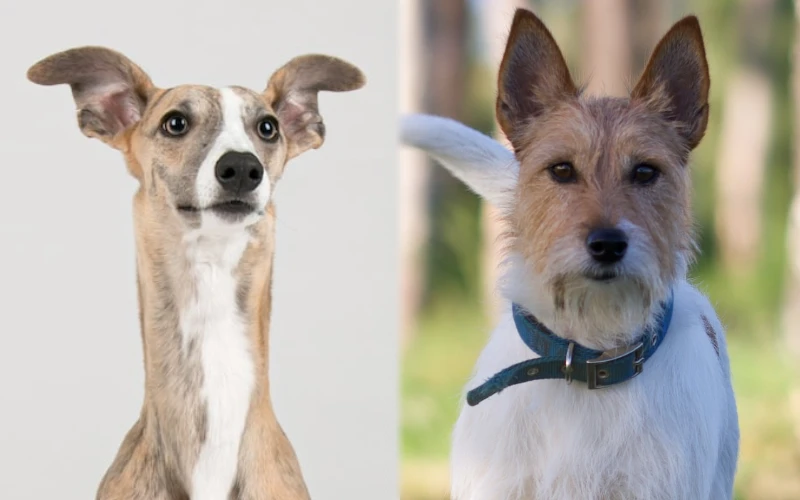Click Below to Skip Ahead
If you’re an active person looking for a dog to join you on daily hikes or runs, the Jackawhip might be just the mixed breed for you. As a small to medium-sized pup with big-dog energy, the Jackawhip will bring mischief, playfulness, and personality to your family. Keep reading to learn more about this unique hybrid and whether they might fit your household.
Breed Overview
Height:
10–22 inches
Weight:
9–40 pounds
Lifespan:
12–15 years
Colors:
Black, white, blue, fawn, brindle, red, and white with these color markings
Suitable for:
Active families or individuals with time to devote to training and exercising their pets
Temperament:
Playful, affectionate, friendly, intelligent, sometimes stubborn, good with other dogs
The Jackawhip, sometimes called the Jack Whippet, is a deliberate cross between a Jack Russell Terrier and a Whippet. Sleek, elegant Whippets were first developed to hunt fast game by sight. Small but scrappy Jack Russell Terriers are no-nonsense workers bred to catch and dispatch small prey.
These two breeds share a similar hunting background but are otherwise quite different in appearance and personality. Because of this, you might not know what to expect if you’re considering adding a Jackawhip to your family. Keep reading to find out more about the Jackawhip, including what you need to know about caring for one.
Jackawhip Characteristics
Jackawhip Puppies
To find a Jackawhip puppy, you’ll likely need to look for a breeder rather than rely on rescue and adoption. One good option is to search for breeders creating “purpose-bred” mixes for canine sports or hunting. Jack Russells and Whippets are both athletic breeds, and the Jackawhip is the type of mix the breeders would produce.
A Jackawhip puppy may vary quite a bit in size, color, and coat type. However, the one thing they’ll all have in common is a need for early socialization. Whippets tend to be sensitive and fearful, while Jack Russells are headstrong and sometimes overconfident.
Jackawhip puppies may take after either parent breed, so they’ll need socialization to build their confidence or ensure their natural boldness doesn’t make them reactive or dominant as they grow. It’s especially important to socialize a Jackawhip with kids and other dogs.
Both parent breeds can be good with children but generally need time to adjust to loud, fast-moving, tiny humans. Jack Russells may clash with other dogs, especially of the same sex, and early socialization of a Jackawhip can help prevent issues later in life.

Temperament & Intelligence of the Jackawhip
As with any mixed breed, the Jackawhip’s temperament can resemble either parent or be a combination of the two. Jack Russells and Whippets have different personalities in many ways, so it can be hard to predict the temperament of a Jackawhip. They will most likely be playful and energetic but could be calm like a Whippet or in constant motion like a Jack Russell.
Jack Russells are alert, independent, mischievous, and often noisy dogs. Whippets tend to be quiet couch potatoes after they exercise. Whippets and Jack Russells are both smart, so the Jackawhip will be an intelligent dog, but training may still be tricky, as we’ll discuss later in the article.
Are These Dogs Good for Families?🏡
Jackawhips can be good family dogs with proper socialization. As we mentioned, Whippets can be sensitive and may do better with older, calmer kids. Jack Russells are playful and energetic enough to serve as excellent playmates for kids. However, they may not be as patient with kids who don’t respect their space.
Before bringing home a Jackawhip, ensure your kids know how to interact with dogs properly and give them space if needed. Make sure everyone in the family is prepared for the commitment of keeping a Jackawhip entertained, exercised, and busy to prevent behavior problems.
Does This Breed Get Along with Other Pets?🐶 😽
Whippets and Jack Russell Terriers usually get along with other dogs when properly socialized, and most Jackawhips should do fine with other canines. However, like many terriers, the Jack Russell can be feisty and may occasionally pick fights. Supervise your Jackawhip as they meet unfamiliar dogs if they inherit this terrier trait.
Jackawhips are generally not recommended for homes with cats or small exotic pets. Both parent breeds have a strong prey drive, especially Jack Russell Terriers, who were bred to catch and kill. Some Jackawhips can learn to live with large, dog-savvy cats, but it’s safest to stick with canine housemates for these pups.
Things to Know When Owning a Jackawhip
In many ways, Jackawhips are relatively low-maintenance dogs. However, they require a firm commitment to daily exercise and often some creative training techniques. Here’s what you need to know when owing a Jackawhip.
Food & Diet Requirements🦴
Healthy Jackawhips typically don’t have any special diet requirements. You’ll want to feed your dog the appropriate food for their life stage. Ask your vet to help you calculate how many calories your Jackawhip needs each day. Whippets have a light frame that doesn’t carry excess weight well, so keeping your Jackawhip at a healthy size is vital, especially if they physically resemble the Whippet.
Exercise🐕
While Jackawhips are generally energetic dogs, their exercise needs will vary somewhat based on which parent they most take after. Whippets enjoy running, but they’re usually happy to relax once they run out of energy. Jack Russell Terriers, on the other hand, are nearly tireless.
They can develop destructive habits if they don’t get enough physical and mental exercise daily. You should plan on giving your Jackawhip at least an hour of vigorous exercise each day, but don’t be surprised if more activity is required.
Training🦮
The Jackawhip is typically a smart, often mischievous dog. They may also be a bit stubborn and independent, especially if they take after their Jack Russell parent. Start training and socialization early but keep training sessions short.
The Jackawhip frequently has a short attention span, so keep training sessions brief and positive. Canine sports offer a good mixture of physical and mental activity that may appeal to the athletic Jackawhip. Agility, lure coursing, and flyball are all excellent options.
Grooming ✂️
The Jackawhip’s coat length and type may vary somewhat, but their grooming needs remain low no matter what. A weekly brushing is usually enough to keep their skin and coat healthy. The Jackawhip sheds but not excessively due to their lack of an undercoat.
Although their coat is easy to maintain, the Jackawhip’s nails should be trimmed regularly to prevent ingrown nails and other injuries. Also, you should check and clean their ears regularly and brush their teeth daily. You can also use dental treats to prevent tartar and plaque from accumulating.
Health and Conditions❤️
The Jackawhip may inherit any genetic condition common to either parent. Fortunately, both Whippets and Jack Russell Terriers are generally healthy overall. Look for a breeder who can provide you with health records and proof they’ve completed all recommended health screenings before breeding.
- Deafness
- Eye Conditions
- Bloat
- Luxating patella
- Von Willebrand’s Disease
- Mitral valve disease
Male vs Female
Unneutered male Jackawhips, like those of any breed, can exhibit more dominant and possibly aggressive behaviors than females or neutered males. They also frequently display sex-related behaviors like marking and humping. Female Jackawhips go into heat about twice a year unless they’re spayed. Some Jackawhips may have trouble getting along with dogs of the same sex.
3 Little-Known Facts About the Jackawhip
1. It’s Hard to Predict What They’ll Look Like
Jack Russell Terriers come in long and short-legged varieties. They may have smooth, broken, or rough coats. Whippets are thin, deep-chested, and smooth-coated. They also come in multiple colors and patterns with and without white markings. With that kind of parentage, good luck predicting what the Jackawhip will look like!
2. They Are British in Origin
While we don’t know where the first Jackawhips were bred, their origins can be traced across the pond. Both Whippets and Jack Russell Terriers were developed in England in the 19th century and remain popular in the country.
3. They Are Not to Be Trusted Off the Leash
Whippets can run as fast as 35 miles per hour, while Jack Russell Terriers frequently refuse to come when called. Both breeds possess an intense prey drive and may take off in pursuit of a squirrel or cat at any time. You can see why a Jackawhip should always be kept safely on a leash or behind a secure fence.
Final Thoughts
If you have the energy and patience to meet their exercise, training, and socialization needs, the Jackawhip can make an excellent pet. Jackawhips can easily become bored and destructive without enough mental and physical stimulation like their Jack Russell Terrier parents. This is not a “hands-off” breed when it comes to shaping their behavior, and prospective Jackawhip owners should be aware of the commitment they’re making. Before you fall for the adorable face and playful energy of the Jackawhip, make sure you know what it takes to keep them happy, healthy, and well-behaved.
Featured Image Credit: Left – S J, Unsplash | Right – Dave Swain, Unsplash














